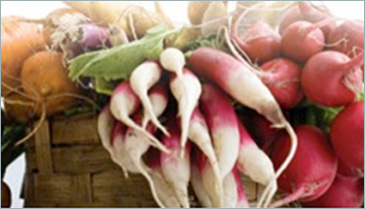 Cary Neff
Cary Neff
Contributing Author to Experience Life
Bring color and warmth to your table with autumn’s earthy harvest.
Just as the leafy salads of summer fade away, autumn offers up a hearty selection of satisfying root vegetables. Earthy and nutritious, these long-storing delights are easy to prepare — and they bring warm comfort to your dinner table.
FOOD BASICS
The edibles we call “vegetables” are harvested from many different parts of plants — tubers, roots, bulbs, stems, stalks, leaves or flowers. What we call “root vegetables” are actually a mix of tubers (potatoes, sunchokes), tuberous roots (sweet potatoes), taproots (carrots, parsnips), taproots/ stems (beets, celeriac, radishes, rutabagas, turnips), and bulbs (garlic, onions, shallots). Root vegetables will keep for several weeks (carrots, garlic, onions, radishes, beets) or up to two months (potatoes, rutabagas, turnips), making them a reliable and economical choice. For the best textures and flavors, select firm, fresh-looking, brightly colored root vegetables. Avoid those with shriveled skin, and do not eat greened potatoes, which contain abnormally high alkaloid levels.
NUTRITIONAL KNOW-HOW
Most root vegetables are good sources of vitamin C, a powerful antioxidant that also helps your body absorb iron. They also offer a range of other vitamins, phytonutrients and minerals: potassium (potatoes, radishes and parsnips), calcium (turnips), complex carbohydrates (potatoes), beta-carotene (carrots), vitamin B6 (potatoes), phosphor (turnips), folate (radishes), magnesium (turnips) and vitamin B (beets). Combine them in dishes for a healthy and varied mix of nutrients. Because most root vegetables are filling and relatively starchy, they make a great substitute for grain-based dishes like pasta and white rice.
KITCHEN TRICKS
Store root vegetables (except potatoes) loosely covered in the refrigerator, where they will keep for three to four weeks. Potatoes are better off in a cool, dry drawer or basket (remove any plastic bags!).
The skins of root vegetables hold many of their nutrients. Very young, fresh roots like beets and turnips are fine to enjoy with their nutritious skin intact, but older, larger, thick-skinned root vegetables require peeling.
Avoid cooking turnips in aluminum or iron pots. Their flesh contains anthoxanthin pigments that interact with these metals. Though still edible, the turnips will turn an unappealing grayish color.
Here is a recipe to try!
ROASTED ROOT VEGETABLES
Makes eight servings
- 2 medium parsnips, peeled, cut into 2-inch sticks
- 2 medium carrots, peeled, cut into 2-inch sticks
- 2 medium beets, peeled, cut into 2-inch sticks
- 2 medium sweet potatoes, peeled, cut into 2-inch sticks
- 2 tsp. extra-virgin olive oil
- 1/2 tsp. sea salt
- 1/4 tsp. freshly ground black pepper
Preheat the oven to 450 degrees F (230 degrees C). Place the vegetables on a baking sheet. Mix the vegetables with the olive oil. Season with salt and pepper. Roast until browned and al dente (slight bite remaining) for 45 minutes, stirring every 10 minutes.




